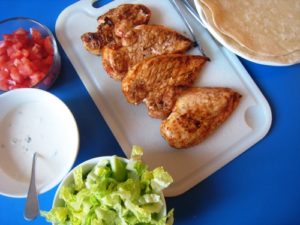To celebrate the births of not one, not two, but three baby girls among the Eat Well, Spend Less bloggers, this month we’re talking about all things baby- and food-related. From meals to take new moms to easy postpartum snacks, you’ll find tons of practical tips…and hopefully a few gratuitous baby pictures as well!
As for me, I’m talking homemade baby food. As I mentioned before, making our oldest daughter’s baby food was really one of the first “green” decisions I made.
Although I used store-bought baby food from time to time — and a lot with #3 — homemade baby food is not only healthier (since there are no preservatives, it’s often raw and you have more control over the quality of the ingredients you use) but it also costs pennies on the dollar.
That said, it can be intimidating to know where to start, so let’s take a look at the basics. There are a few different methods you can use to make baby food, with pros and cons to each:
Table of Contents
Smash & Mash
My favorite baby food for any age is a simple banana or avocado, mashed with a fork. It doesn’t get much easier than that, and avocados are full of healthy fat that make them a great choice for growing babies.
Similarly, as you introduce new foods, you can mash a lot of cooked fruits and veggies with a fork — apples, sweet potatoes, carrots, squash, etc. Include these foods as part of your family meals so that you can mash a bit for baby on the side rather than having to prepare special food on top of what you’re already making.
And as baby gets older, you can easily transition to chunkier servings and pieces he or she can pick up on her own.
Truly, it’s the lazy mom’s approach to homemade baby food! (And I say that with my hand raised proudly as one such lazy mom!)
Make it Fresh
For foods that can’t be smashed (meat, veggies with a skin, etc.), you have two choices…use a handheld grinder or, um, chew it slightly. I know, I know…it sounds a little gross. But I’ve done it, and it works.
The benefit of grinding food at the table is that you can serve baby what you’re eating. You still want to follow the introduce-one-food-at-a-time method to identify potential allergies, but once you have a list of safe foods, this is a great approach. It gets baby used to the flavors your family enjoys so that the transition to table food is a breeze!
Make Ahead & Freeze
When most people think of homemade baby food, I think this is the method that comes to mind. It involves a food processor, ice cube trays and your freezer. Instead of making single servings of whatever you’re eating, you actually make large batches ahead of time, portion them in ice cube trays (for easy serving sizes) and freeze. Once they’re frozen, you can pop them out and freeze them in another container.
Not only does freezing ahead mean you always have food ready, like you would with store-bought baby food, but it’s also great for on the go, whether you let it thaw in the diaper bag (which is probably against official recommendations…) or take it with you to your destination and thaw there.
Just Don’t Make Anything
Probably the simplest method of baby food is to simply wait longer and introduce it when they’re ready for texture rather than trying to create thin purees that make it past the gag reflex. This method is commonly called baby-led weaning, although it’s more about feeding than weaning. The idea is that you introduce baby to actual solids — soft ones, but still solids (as opposed to purees) — and they practice gumming those right from the start.
According to proponents of this method it produces less picky children and is more like the way our ancestors would have introduced solids to their babies. We used this method, mostly by default, with #4 because making and feeding purees was a time-consuming task with four children under six years old!
Let’s Talk About Gag Reflex
On that note, let’s talk about gagging, because babies’ natural gag reflexes are pretty amazing! An infant will gag almost 100% of the time when something comes too close to their throat. This strong and effective reflex keeps them from choking when they put something — food or not — in their mouth. This gag reflex is the reason baby-led weaning works. Babies discover tastes and textures with their mouths but don’t choke on solid foods because the gag reflex keeps it away from their throat until they’ve learned how to properly swallow. I think it’s awe-inspiring how it works!
Books to Read
When our oldest daughter was a baby (back in January of 2005, according to Amazon), I purchased both Super Baby Food by Ruth Yaron and Mommy Made and Daddy Too!: Home Cooking for a Healthy Baby & Toddler by Martha and David Kimmel. These are great resources, but I’ll admit I tended to go with the flow with the rest of my girls and didn’t really need a book to tell me how to puree the veggie of the day.
However, Super Baby Food has long been considered the definitive guide on homemade baby food and contains recipes for homemade cereal, toddler snacks and more if you want a complete how-to guide you can reference in your kitchen!
Eat Well, Spend Less
Be sure to visit my fellow Eat Well, Spend Less bloggers for even more ideas for welcoming a new baby with food:
- Jessica from LifeasMOM
- Aimee from Simple Bites
- Amy from Kingdom First Mom
- Carrie from Denver Bargains
- Katie from Good Life Eats
- Katie from Kitchen Stewardship
- Shaina from Food for My Family
- Tammy from Tammy’s Recipes
How do you approach baby’s transition to solid food? Do you make your own? Start early or wait until baby is older?




